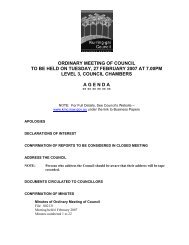Pymble Business Park - Ku-ring-gai Council
Pymble Business Park - Ku-ring-gai Council
Pymble Business Park - Ku-ring-gai Council
Create successful ePaper yourself
Turn your PDF publications into a flip-book with our unique Google optimized e-Paper software.
INTRODUCTION<br />
This Part applies to development that will have an impact on areas<br />
identifi ed as the Greenweb in this DCP.<br />
The Greenweb identifi es lands containing signifi cant strategic biodiversity<br />
values, considered important in the support of native fl ora, fauna and<br />
ecological processes and have a particular focus on key vegetation<br />
communities, threatened populations, species and their habitats.<br />
Lands identifi ed as of biodiversity signifi cance in the <strong>Pymble</strong> <strong>Business</strong><br />
<strong>Park</strong> LEP are broken down into biodiversity categories:<br />
Category 2 Support for Core Biodiversity Lands<br />
Category 3 Landscape Remnant<br />
Category 4 Biodiversity Corridors and Consolidation<br />
Category 5 Canopy Remnant<br />
as shown on the Greenweb maps in 13R.1 of this Part.<br />
Note: Category 1 Core Biodiversity Lands does not occur in the <strong>Pymble</strong><br />
<strong>Business</strong> <strong>Park</strong> and has therefore not been included in this DCP.<br />
The majority of areas within the Greenweb include native vegetation<br />
canopy. However in some areas exotic and unvegetated areas have<br />
been included (eg Category 4). Such areas are included to facilitate the<br />
improvement of connectivity between core habitats and may provide<br />
additional functions such as protection of water quality. These measures<br />
will help to maintain and restore the health, diversity and connectivity of<br />
biodiversity within <strong>Ku</strong>-<strong>ring</strong>-<strong>gai</strong> and improve resilience under future climate<br />
change.<br />
Lands excluded from Greenweb may still contain or provide habitat for<br />
threatened ecological communities, species or populations as listed under<br />
the NSW Threatened Species Conservation Act 1995, the NSW Fisheries<br />
Management Act 1994, or the Environment Protection and Biodiversity<br />
Conservation Act 1999. Absence of these areas from the Greenweb does<br />
not prevent the need for consideration and protection under these Acts.<br />
The purpose of the Greenweb is to foster a consistent and strategic<br />
approach to biodiversity management. There are considerable benefi ts<br />
to natural resource planning at this scale, however investigations at a<br />
site scale for individual proposals may identify inaccuracies or on ground<br />
changes. <strong>Council</strong> will consider on merit, arguments relating to any<br />
proposed mapping variations based on the methodology outlined in the<br />
<strong>Ku</strong>-<strong>ring</strong>-<strong>gai</strong> Biodiversity and Riparian Lands Study. For a brief summary<br />
of the methodology see 13R2 of this Part. In all cases the onus of proof<br />
rests with the proponent.<br />
Where there are inconsistencies between this Part and Part 6.3<br />
(Landscaping) or Part 6.6 (Deep Soil Landscaping) of this DCP, this Part<br />
prevails to the extent of any inconsistency.<br />
p 176<br />
Draft <strong>Ku</strong>-<strong>ring</strong>-<strong>gai</strong> <strong>Pymble</strong> <strong>Business</strong> <strong>Park</strong> Development Control Plan 2012

















